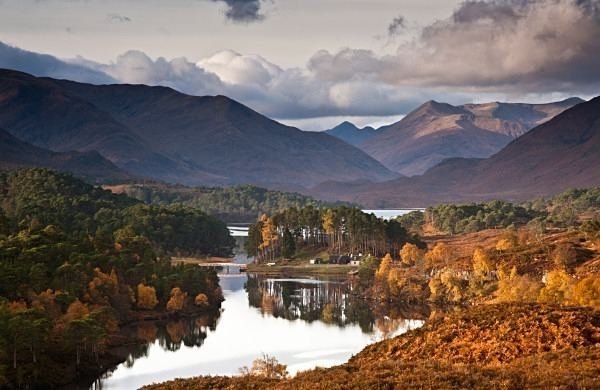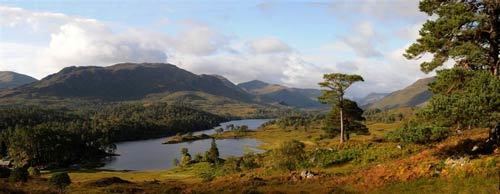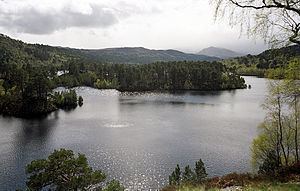 | ||
Similar | ||
Glen Affric (Scottish Gaelic: Gleann Afraig) is a glen south-west of the village of Cannich in the Highland region of Scotland, some 15 miles (24 km) to the west of Loch Ness. The River Affric runs along its length, passing through Loch Affric and Loch Beinn a' Mheadhoin (Loch Benevean).
Contents

Glen affric scotland mountain walking
History

Glen Affric, also written Glenaffric, was part of the lands of the Clan Chisholm and the Clan Fraser of Lovat from the 15th to the mid 19th centuries. By the early 15th century, Lord Lovat had passed the lands to his son Thomas who in turn passed it on to his son, William – recorded in Burke's Landed Gentry Scotland as William Fraser, first Laird of Guisachan. The lands included regions that would become the Glen Affric deer park and the Guisachan Estate – including the village of Tomich. In 1579, Thomas Chisholm, Laird of Strathglass, was imprisoned for being a Catholic.
The Battle of Glen Affric took place in 1721

There exists in the Scottish Register of Tartans – possibly from the late 17th century – a "Glenaffric Fragment".

By 1854, Dudley Marjoribanks, later Lord Tweedmouth, had acquired the lairdship of Glen Affric and Guisachan, from Laird Fraser, whose family had built the original Guisachan Georgian manor house around 1755. By the 1860s, Lord Tweedmouth, as the new laird, had "much enlarged" the "laird's house", using Scottish architect Alexander Reid who designed many buildings on Tweedmouth's vast Glen Affric Estate, including an entire village - Tomich - and the Glen Affric Hunting Lodge, described in appearance as "castle-like". Tweedmouth had enjoyed a long lease on shooting rights over much of Glen Affric since 1846, and, following his acquisition of the lairdship, he initiated the first breed of golden retrievers at kennels near Guisachan House. He put the retrievers to good use at the shooting parties he hosted at Glen Affric Lodge.
Royal connections

The Duke and Duchess of York are reported in The Graphic, 25 September 1897 to have visited the Guisachan Estate in Strathglass, including Glen Affric Lodge and deer park; "The Duchess, (later Queen Mary), driving around the estate in 1897 with Lady Tweedmouth in 1897". Baroness Tweedmouth – known and loved in the Highlands as the Lady of Glenaffric and Guisachan – had been born Lady Fanny Spencer-Churchill, and the name of her nephew, who came to her estate in 1901, was Winston Churchill, who amused himself learning how to drive a car in the grounds of this part of Glen Affric.

Although Edward Marjoribanks, 2nd Baron Tweedmouth had inherited the lairdship of Glenaffric and Guisachan, the Clan Marjoribanks' ownership ended with Edward’s son, Dudley Churchill Marjoribanks, who became 3rd Lord Tweedmouth in 1909. He and his wife had two daughters, but no male heir. For the next 27 years, the estate was owned by the family of Newton Wallop, 6th Earl of Portsmouth (1856–1917). The entire property, then consisting of 22,000 acres (8,900 ha), had been sold by 1936 to a Mr Hunter. It was this laird that resold the Glen Affric deer forest to the west and a large area of grazing land to the Forestry Commission.

A Lady Islington acquired the Guisachan portion of the estate in 1939 but let the property go to ruin. In 1962 the Guisachan estate (now considerably reduced in size) was bought by a descendant of the Frasers of Gortuleg. In 1990, this later generation laird wrote a booklet concerning his Fraser ancestors who had once owned Guisachan – "Guisachan, A History by Donald Fraser".
21st century

The Scotland Forestry Commission had bought much of the glen in 1951, and today the remainder consists of a number of sporting estates, including the Glen Affric Estate with its 10,000 acres (4,000 ha), Baronial castle and associated deer park. It was reported that since 2008, the Glenaffric lairdship has been held by David Matthews. Although the "castle-like" lodge is a private home for the Matthews family, their 10,000-`acre estate – including its trout loch and deer park – is available to hire for those wishing to enjoy the "activities favoured by the noble elite"; trout fishing on Loch Affric, sailing, clay pigeon shooting, target shooting and game shooting.
Nature
The area is a Caledonian Forest Reserve, a National Scenic Area and a National Nature Reserve. Often described as the most beautiful glen in Scotland, it contains one of the largest ancient Caledonian pinewoods in Scotland as well as lochs, moorland and mountains.
Affric Lodge – the hunting lodge built by Lord Tweedmouth – is located on a peninsula in Loch Affric, while a Scottish Youth Hostels Association hostel is further up the glen at remote Allt Beithe.
The glen is part of the Affric/Beauly hydroelectric scheme, constructed by the North of Scotland Hydro-Electric Board. Loch Mullardoch, in the neighbouring Glen Cannich, is dammed, and a 5 km tunnel carries water to Loch Benevean, which has also been dammed. From there, another tunnel takes water to Fasnakyle power station, near Cannich.
The mountains of Glen Affric are a popular destination with hikers, climbers and mountain bikers.
